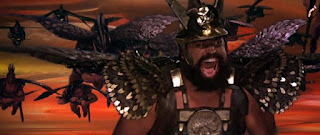53 years ago today, Star Trek aired for the first time. The episode chosen was in fact the sixth to be filmed, 'The Man Trap' written by George Clayton Johnson, featuring the infamous shape-shifting salt vampire creature. The episode saw a number of firsts, including the first death of en Enterprise crew member (not, though, one of the poor red shirts) with McCoy pronouncing 'Dead, Jim' and later 'He's dead' ('He's dead, Jim' would have to wait until 'The Enemy Within'.) Spock also says for the first of many times, 'Fascinating.'
The episode always comes across as somewhat melancholy to me, what with McCoy's long lost love, the loneliness of life on planet M-113 and the ultimate fate of an entire intelligent species. The story also sees science fiction melded with horror, a common enough pairing and one that would be used again in Star Trek - for example, 'Wolf in the Fold' and 'Cat's Paw' - yet this episode comes across as unsettling and weird. A large part of this is due to Alexander Courage's score, with the use of an electric organ and a flute particularly sticking in my mind. It really underlined the creepiness of several scenes.
'The Man Trap' doesn't make many favourites lists, yet there's a lot to enjoy, including some elements which disappeared as the series found its feet. I can't be alone in enjoying the scene between Spock and Uhura and wondering if anything could, or should, have developed from it. I'm quite sure that J.J. Abrams took his cues from it when he worked on the first Kelvinverse Trek movie. There's also the easy camaraderie between the crew, for example Kirk/Uhura, Rand/Sulu that was a little different here and helped convince me that here was a group of professionals who worked well together and liked and respected one another. The foundations of the Kirk/Spock/Bones troika are clearly in place, with Kirk relying on both for advice. There's other stuff which isn't so good - what immediately springs to mind is the crewmen leering at Rand in the corridor. Especially today, it's uncomfortable to see. It wasn't the only time that Rand was reduced to a mere sexual object which was a great pity; I always felt she showed bravery and a cool head under stress which I would have liked to see develop had she remained as a regular cast member. She didn't so it's a moot point.The 'monster' was effective enough, though we only see its true form in the final moments. There is regret afterwards at its death but Kirk is quite unequivocal in his resolve to kill the creature and understandably so. It's butchering his crew like they were chicken wings on a buffet table. The creature is perfectly capable of communicating and simply asking for the salt it needs - and doesn't, choosing instead to keep on killing, even the one human who showed it compassion and understanding, the horribly compromised Crater. It's quite a contrast to the later Horta creature in 'The Devil in the Dark' which does choose to ask for help - 'no kill I'.
Yes, 'The Man Trap' isn't a perfect choice to have kicked off the series but there was very little choice open to the production staff, given the state of other episodes currently filing and in post production. Thank goodness, then, for director Marc Daniels who brought 'Man Trap' in on time, enabling Star Trek to meet its air date. Daniels was efficient, establishing procedures that were used even when he wasn't involved in an episode and he directed more episodes of TOS than anyone else. Over the following weeks the audience would be introduced to Charlie Evans, Balok, the Romulans and a slew of other characters and Trek staples. The show found its feet due to the talent assembled - I don't think it can ever be overstated how much of a group effort went into Trek - I say this not to downplay Gene Roddenberry and his massive contribution, but rather to point out that many others made valuable, important contributions of their own. For example, the other Gene, Gene L Coon, for example the ridiculously unsung Bob Justman. I could go on and probably will in other blog posts.
Happy fifty third, then, Star Trek. You've given me so much and helped keep keel even in the most trying of times. Star Trek is far more than a TV show; it's a philosophy, an optimism, a belief that somehow, somehow we will get through the hard times to see better, brighter horizons. Not a bad legacy to give to the world.
You might want to also read https://en.wikipedia.org/wiki/The_Man_Trap" , https://memory-alpha.fandom.com/wiki/The_Man_Trap_(episode)



















